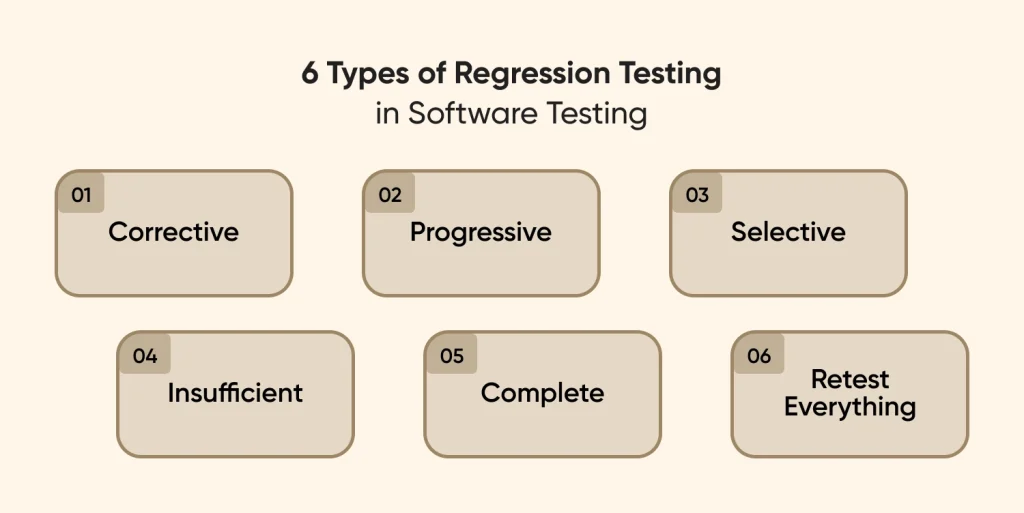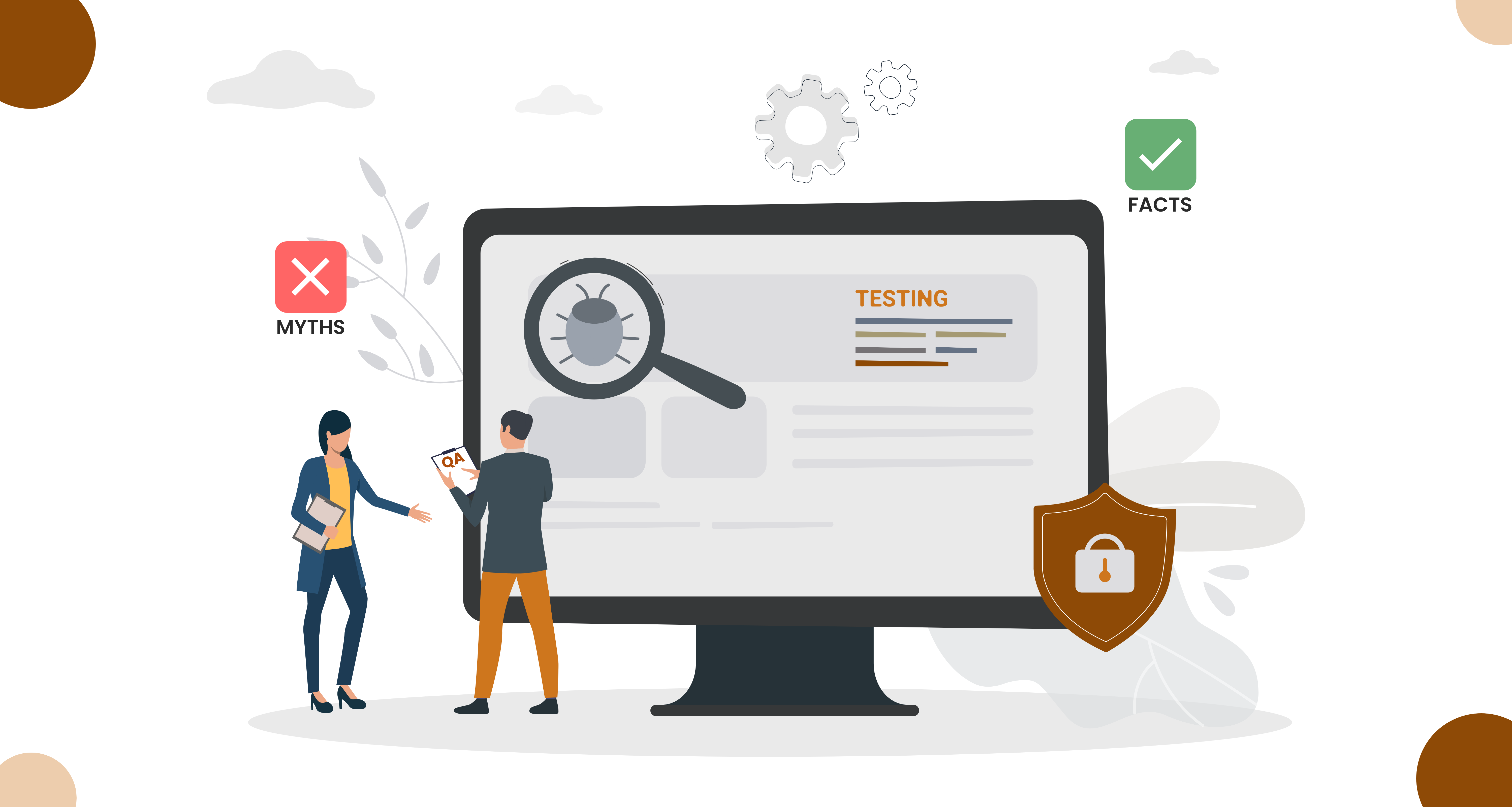An architect builds a skyscraper and puts in so much effort to align each beam to match the builder’s goal. However, there’s a tremor-a structural defect that doesn’t show up right away but gets bigger with every new development.
The stability and quality of software products must be guaranteed in the fast-paced world of rapid software development, where updates and revisions happen often. In this case, regression testing is essential which is offered under the best mobile app testing services by a software development company.
Regression testing is a basic testing procedure that involves continuously testing a tool, application, or system’s current features as it gets updated. Regression testing is done by testers to make sure that new and live features of an application continue to perform properly. In this testing strategy, the quality analyst examines both the functional and non-functional parts of the current features to make sure there are no new problems or faults in the application.
Let’s start with the understanding of regression testing in software testing with an example.
What is Regression Testing in Software Development?
With regression testing, you can confirm that the codebase modifications do not affect the functionality of the program as it currently stands. These code modifications can, for instance, involve enhancing an existing feature, creating new ones, or repairing problems.
Regression testing, to put it another way, is the process of running previously cleared test cases against the latest version of the application to ensure all of its features are operational. Regression testing is also a set of tests rather than a single test that is run each time new code is added.
If you still need to understand, let us explain with an example.
Regression Testing Example
Let’s look at an online shopping application. Assume that a new functionality enabling consumers to apply discount codes at checkout is added by the development team. The following actions could be conducted to conduct regression testing:
- Baseline Testing: To provide a baseline of expected behavior, a series of test cases is first run on the current version of the application. This entails testing several features such as exploring products, adding items to the cart, and completing the transaction without using any coupons.
- Code Changes: The application’s development team adds a new functionality that allows users to apply discount codes at checkout.
- Selecting a Regression Test: These tests include test cases that are relevant to the affected regions, like order calculation and checkout. The purpose of these test cases is to confirm that the code modifications do not affect the functionality that currently exists.
- Test Execution: To make sure the new feature functions as intended and doesn’t interfere with previously operational areas, the chosen regression test cases are run on the updated application.
- Comparison and Analysis: To find any variations or conflicts, the regression test results are compared to the findings of the baseline test. Failures or unusual behavior are looked into carefully and submitted as defects to the development team so they can be fixed.
- Retest and Confirmation: Following the resolution of the issues found, the affected test cases are rerun to verify that the solutions are successful and that the functionality that was previously operational has been reinstated.
How to Perform Regression Testing?
Regression testing is generally not implemented in a set way. Hire quality assurance testers or analysts who would be aware of a few common regression testing techniques, though.
Step 1: Selecting Regression Tests
Here, you choose the test cases that need to be retested, as the name implies. The modules where there are source code changes will determine which test cases are chosen, and you won’t test the complete test suite.
However, the test cases come in two categories: Reusable Test Cases and Obsolete Test Cases. You won’t take into account Obsolete ones for the next testing cycles, but Reusable ones will be used for regression cycles.
The following tips will help you find the reusable test cases:
- Prone to errors
- Check an app’s functionality
- Contain user-visible features
- Recent modifications to the source code
- Testing has previously been completed successfully
- Testing has previously failed.
- Are connected to boundary-value and integration
Step 2: Calculate the Time to Run Test Cases
Estimating how long it will take to run the chosen test cases is the next stage. A few things that impact the execution time are the generation of test data, the QA team’s preparation of regression tests, the examination of each test case, etc.
Step 3: Determine Which Test Cases can be Automated
The QA team can choose which test cases to automate in this step by taking into account the findings of the exploratory testing. You can reuse the same script repeatedly and achieve faster results using automated test cases compared to manual testing. The test cases should therefore be divided into two groups: (i) manual test cases and (ii) automated test cases.
Step 4: Prioritising Test Cases
This is where you compile all of the test cases and rank them: high, medium, and low. You will run the high-priority test cases first, then the medium- and low-priority test cases, based on this evaluation. The product’s functioning and user participation will determine the priority.
The waterfall structure of priority is shown below:
- All of the core characteristics are covered in the most important test cases.
- Necessary features but not part of the primary functionality.
- Technical debt-related test cases.
Step 5: Putting Test Cases to Use
It’s time to run each test case individually and determine whether the product is functioning as it should. Depending on your needs, you can choose between automation and manual testing. Using functional testing tools such as Selenium, QTP, Watir, and so on enables you to run the test cases for automated regression testing more quickly.
You must now be familiar with the process of performing regression testing, right? What are the most widely used techniques for regression testing, nevertheless, is still an open subject. So, in the section that follows, let’s examine that element.

What are the Software Regression Testing Best Practices?
1. Recognizing the Scope of Testing
It’s critical to understand the regression testing process’s scope before beginning. The rationale is that any testing project’s scope, duration, and objectives can differ. You will be able to better plan the execution of your regression cycle if you are aware of scope differences.
2. Automating Test Execution
Automating as much of the test execution process as possible is the second step in regression testing. In addition to improving uniformity and quality of test results, automation can save time, money, and effort. Additionally, automation can facilitate continuous software system supply and integration as well as quicker feedback loops. Automation, however, is not a panacea; test scripts and frameworks must be carefully planned, designed, and maintained. Using a framework or test automation tool that is compatible with the technology, platform, and architecture of the software system is a good practice.
3. Managing the Test Data
Effectively managing the test data is the third phase in the regression testing process. The input and output data used to run the test cases and confirm the anticipated results is known as test data. Test data ought to be trustworthy, realistic, and pertinent to the goals and scenarios being tested. It is imperative to isolate, regulate, and safeguard test data to prevent any potential interference or contamination from other sources or tests. Using a method or instrument that facilitates the generation, modification, and removal of test data is a recommended practice.
4. Analyzing the Test Results
Reporting and analyzing the test results is the fourth phase in the regression testing process. The outcomes and observations of the test execution, such as pass, fail, mistake, or defect, are called test results. Test results ought to be promptly and properly recorded, shared, and documented with all pertinent parties, including developers, testers, managers, and clients.
Analyzing and assessing test results is also necessary to determine the underlying causes, effects, and fixes for any problems or flaws. Using a dashboard or test reporting tool that offers a thorough and graphical summary of the test results is a recommended practice.
5. Improving the Process
Continuous process improvement is the fifth step in the regression testing process. The set of procedures, guidelines, and practices used in the test process are what make up the regression testing procedure. To guarantee the test process’s efficacy, efficiency, and quality, it should be routinely evaluated, optimized, and reviewed. The software development process, the software system’s business objectives, and the test procedure should all be in sync with one another. Using a framework or test improvement model to direct the improvement of the test process is a good practice.
6. Monitor ROI
The most crucial metric for assessing the effectiveness of your regression testing effort is the return on investment. RoI should always be monitored by QA teams using the sophisticated analytics and reports produced by automation solutions. It will assist you in seeing the realities on the ground and the areas that require development.
You might now have a practical understanding of the recommended procedures for regression testing that QA managers ought to adhere to.
6 Types of Regression Testing in Software Testing

1. Corrective
When there hasn’t been any modification to the source code of your application, corrective regression testing makes sense. Rather than creating new test cases, you will test the current functionalities and their corresponding test cases to see if the system is operating as intended.
2. Progressive
For changing the testing specifications and creating new test cases, progressive testing will work perfectly. When a new component is added to the system this kind of testing is implemented. This is because it enables you to confirm that modifications have no negative effects on the original components.
3. Selective
As the name suggests, selective testing limits test coverage to a preset subset of previously created test cases. As such, you only test a few components rather than retesting the complete system.
4. Insufficient
To determine the impact of incorporating new system components, partial testing is conducted. For instance, how the system might be affected by a new line added to the source code. In contrast to selective testing, in this sort of testing, new functionalities are tested alongside the existing ones. You can assess their impact in this manner.
5. Complete
This means doing a comprehensive system test all at once. Comparable to acceptability testing, it determines whether the user experience is jeopardized by the addition of one or more modules. Testing is finished just before the product’s formal release.
6. Retest Everything
The primary objective of this testing is to rerun every test case in the testing suite to make sure that modifications made to an application’s source code haven’t introduced any problems. This type of testing takes a lot more time and effort from the QA team than other types of regression tests.
You now have a better understanding of the range of regression software testing services available from the QA team. Regression testing is now done using a variety of methods, nevertheless, because of automation.
Conclusion
Not many companies disregarded appropriate testing and suffered catastrophic outcomes. Regression testing should have been done before updating or introducing a new feature by organizations to prevent these fatalities. You must have seen from the example above how crucial regression testing is to modern software testing.
Regression testing is essential if you want to provide reliable, high-quality programs that users might stick with. We have given you a thorough understanding of regression testing in this post, along with information on its types, tools, techniques, and other pertinent topics, all while taking those circumstances into account.
But if you’re still interested in learning more or would want to test your products for regression, get in touch with us right now. We would be delighted to offer guidance.
Frequently Asked Questions
What Is Regression Testing in Software Development?
Software testing known as regression testing is done to make sure that no new bugs were introduced by a code upgrade. This is because newly added code could introduce new logic that clashes with previously written code, resulting in errors.
What Are the Best Practices for Regression Testing?
Some of the best practices to follow:
Staying Current with Regression Suite
Having a hands-on understanding of every change 3. Giving test cases a grade
Recognizing the Testing’s Scope
Use Appropriate Test Case Automation
Monitor ROI
How Can Test Environments Be Managed Effectively for Regression Testing?
Make sure the production and test environments are almost identical. Automated tests ought to be conducted in a controlled and reliable environment. Integrate with CI/CD workflow: To enable tests to be executed automatically each time code is committed, incorporate automated regression testing into the CI process.
How Do You Handle Regression Testing in Agile or Continuous Delivery Environments?
Whether there is a major software change or a minor, localized modification, regression testing should always be used. Teams need to make sure that updated code doesn’t interfere with previously written code and that unaltered code continues to function as intended.







